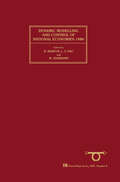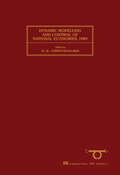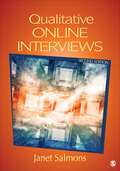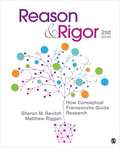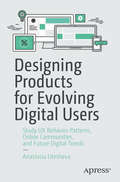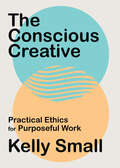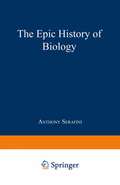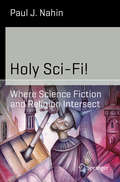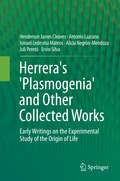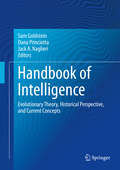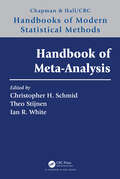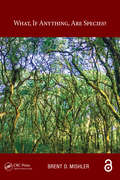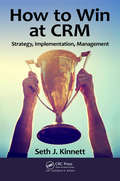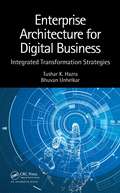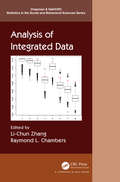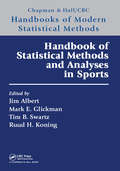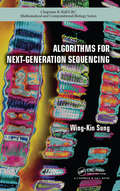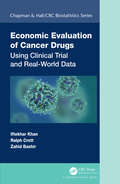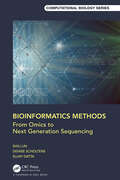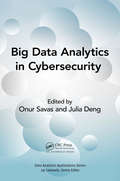- Table View
- List View
Formal Theories of Politics: Mathematical Modelling in Political Science (ISSN #Volume 20)
by P. E. JohnsonFormal Theories of Politics demonstrates the role of formal mathematical models in political science, and aims to convey a sense of the questions and methods which govern the political science research agenda. While there is still much interest in empirical patterns of voting behaviour and public opinion data, there has been substantial growth in emphasis on mathematical theory as a technique for the derivation of testable hypotheses. Topics discussed include: optimal candidate strategies and equilibria in competitive elections; voting agendas and parliamentary procedure in the multidimensional events; revolution, repression and inequality as outputs of dynamics systems. The mathematical techniques are widely varied, including game theory, functional analysis, differential equations, expert systems, stochastic processes and statistical models.
Dynamic Modelling & Control of National Economies 1986: Proceedings of the 5th IFAC/IFORS Conference, Budapest, Hungary, 17-20 June 1986 (IFAC Symposia Series)
by B. Martos M. Ziermann L. F. PauThis IFAC symposium considers the modelling, analysis and control of various economic and socio-economic systems. The volume is divided into three sections covering: economic theory; macroeconomic policymaking - national, sectoral and regional models; mathematical, algorithmical and computational methods of modelling, giving a clear and concise view of the use of computer systems in the world of economics.
Dynamic Modelling and Control of National Economies 1989: Selected Papers from the 6th IFAC Symposium, Edinburgh, UK, 27–29 June 1989 (IFAC Symposia Series)
by N. M. ChristodoulakisThe Symposium aimed at analysing and solving the various problems of representation and analysis of decision making in economic systems starting from the level of the individual firm and ending up with the complexities of international policy coordination. The papers are grouped into subject areas such as game theory, control methods, international policy coordination and the applications of artificial intelligence and experts systems as a framework in economic modelling and control. The Symposium therefore provides a wide range of important information for those involved or interested in the planning of company and national economics.
Qualitative Online Interviews: Strategies, Design, And Skills
by Janet SalmonsThe Second Edition of Qualitative Online Interviews provides researchers the guidance they need to extend the reach of their studies beyond physical boundaries. Focusing on designing, conducting, and assessing data drawn from online interviews as well as from observations, materials, and artifacts collected online, the book emphasizes the use of in-depth interviews in qualitative research or mixed-methods designs. Written in an easy-to-read manner, the thorough Second Edition offers the practical information and scholarly foundations needed to make thoughtful decisions in technology-infused research.
Reason And Rigor: How Conceptual Frameworks Guide Research
by Sharon M. Michelle Ravitch J. John Matthew Matt RigganDesigned for novice as well as more experienced researchers, Reason & Rigor by Sharon M. Ravitch and Matthew Riggan presents conceptual frameworks as a mechanism for aligning literature review, research design, and methodology. The book explores the conceptual framework--defined as both a process and a product--that helps to direct and ground researchers as they work through common research challenges. Focusing on published studies on a range of topics and employing both quantitative and qualitative methods, the updated Second Edition features two new chapters and clearly communicates the processes of developing and defining conceptual frameworks.
Reason And Rigor: How Conceptual Frameworks Guide Research (PDF)
by J. John Matthew Matt Riggan Sharon M. Michelle RavitchDesigned for novice as well as more experienced researchers, Reason & Rigor by Sharon M. Ravitch and Matthew Riggan presents conceptual frameworks as a mechanism for aligning literature review, research design, and methodology. The book explores the conceptual framework--defined as both a process and a product--that helps to direct and ground researchers as they work through common research challenges. Focusing on published studies on a range of topics and employing both quantitative and qualitative methods, the updated Second Edition features two new chapters and clearly communicates the processes of developing and defining conceptual frameworks.
Designing Products for Evolving Digital Users: Study UX Behavior Patterns, Online Communities, and Future Digital Trends
by Anastasia UteshevaDigital user behavior is evolving at an ever-increasing pace, and predicting future trends is a booming business as a result. Users associate technology with their identities now more than ever, and it is up to you as a product designer to enhance their experience for the better. Designing Products for Evolving Digital Users is a 21st century handbook that helps you do just that. By providing insights that allow you to study UX (user experience) behavior patterns, online communities, and future digital trends, Designing Products for Evolving Digital Users instills confidence and fact-based foundations for your digital creations. Author Anastasia Utesheva expertly teaches you how to account for the way the technology impacts the identity of users and how that identity shifts through ongoing interaction with a product or service. She also brings in important case studies on social media, gaming, eRetail, and more to illustrate past examples of technology’s profound impact on communal and individual identity. Digital product design’s ultimate end goal is end user satisfaction. While a myriad of material is available out there consisting of simple tips and tricks for optimal digital design, Designing Products for Evolving Digital Users is a rare and remarkable title that cohesively accounts for all environmental factors involved. Comprehend how distributed technology impacts creation and negotiation of identity and explore communities that form around digital products. UX designers, futurists, students, and industry veterans alike have an abundance of invaluable learning ahead of them in Designing Products for Evolving Digital Users. What You Will LearnLearn how to design digital products/services that resonate with and transform identity of usersStudy how digital impacts formation of identityConsider how digital technology has impacted our world and implications for future digital trendsWho This Book Is For UX designers, digital product creators, entrepreneurs, educators, philosophy of technology enthusiasts, futurists
The Conscious Creative: Practical Ethics for Purposeful Work
by Kelly SmallAn actionable guide to mindfulness and practical ethics for any creative professional who wants to make a living without selling their soul.It can be difficult to live according to our values in a complicated world. At a time when capitalism seems most unforgiving but the need for paying work remains high, it is important to learn how we can be more mindful and intentional about our impact — personal, social, economic, and environmental.As designer and creative director Kelly Small had to do to navigate a crisis of ethics and burnout in their career in advertising, we can admit our complicity in problematic systems and take on the responsibility of letting our own conscience guide our decisions.Start with one or many of these 100+ rigorously researched, ultra-practical action steps:Co-create and collaborateGet obsessed with accessibilityDemand diverse teamsCommit to self-careMake ethics a competitive edgeBe mindful of privilegeCreate for empowerment, not exploitationWith a humorous and irreverent tone, Small reveals how when we release unnecessary judgement and become action-oriented, we can clarify the complicated business of achieving an ethical practice in the creative industries. Discover the power of incremental, positive changes in our daily work-lives and the fulfillment of purposeful work.
The Ingenious Mind of Nature: Deciphering the Patterns of Man, Society, and the Universe
by George M. HallThe Epic History of Biology
by Anthony SerafiniThe search for our elusive human origins and an understanding of the mysteries of the human body have challenged the most inquisitive and imaginative thinkers from Egyptian times through the twentieth century. In The Epic History of Biology, Anthony Serafini - a distinguished philosopher and historian of science - regales the reader with the triumphs and failures of the geniuses of the life sciences. The subtleties of the animal kingdom - anatomy, zoology, and reproduction - along with the complexities of the plant kingdom, have fascinated humanity as far back as 5000 years ago. Astounding ancient knowledge of the arcane curing powers of herbs as well as early experimentation with different chemical combinations for such purposes as mummification led to today's biological technology. Innovative pioneers such as Aristotle, Galen, Hippocrates, and Vesalius challenged the limits of knowledge and single-mindedly pursued their work, often in the face of blind superstition. In superb, lyrical prose Serafini recreates the ideas and theories of these revolutionaries from ancient times through today, against the backdrop of the dogma and prejudices of their time. He explores the inspired revelations that gave birth to such discoveries as the controversial theory of evolution, the humble origins of genetics, the fantastic predictions of quantum mechanics, and the infinite promise of computer technology. Even today the biological sciences are undergoing rapid and kaleidoscopic changes. Every new insight gives rise to a myriad of new ethical questions and responsibilities. The Epic History of Biology confronts these issues head on and predicts the wondrous new directions biology will follow.
Holy Sci-Fi!: Where Science Fiction and Religion Intersect (Science and Fiction)
by Paul J. NahinCan a computer have a soul? Are religion and science mutually exclusive? Is there really such a thing as free will? If you could time travel to visit Jesus, would you (and should you)? For hundreds of years, philosophers, scientists and science fiction writers have pondered these questions and many more.In Holy Sci-Fi!, popular writer Paul Nahin explores the fertile and sometimes uneasy relationship between science fiction and religion. With a scope spanning the history of religion, philosophy and literature, Nahin follows religious themes in science fiction from Feynman to Foucault and from Asimov to Aristotle.An intriguing journey through popular and well-loved books and stories, Holy Sci-Fi! shows how sci-fi has informed humanity's attitudes towards our faiths, our future and ourselves.
Herrera's 'Plasmogenia' and Other Collected Works: Early Writings on the Experimental Study of the Origin of Life
by Henderson James Cleaves Antonio Lazcano Ismael Ledesma Mateos Alicia Negrón-Mendoza Juli Peretó Ervin SilvaThis book collects three outstanding examples of the work of Mexican biologist Alfonso Luis Herrera (1868-1943), a pioneer in experimental origins of life research. Two of the collected works appear here in English for the first time. Herrera's works represent the attempt to deal experimentally with the issue of an autotrophic origin of life, a possibility that was widely accepted prior to Alexander I. Oparin's ideas regarding the possibility of organic synthesis and the origin of life in an early Earth environment. An active promoter of Darwinian ideas in Latin America, Herrera was also among the first 20th century researchers to attempt to “create life in a test tube.”This collection shows the remarkable prescience of researchers in Mexico with regards to laboratory approaches to the problem of the origin of life. It also includes a modern commentary by researchers actively engaged in research in prebiotic evolution and the origins of life, and deeply concerned with the historical development of ideas in these fields. The list includes H. James Cleaves, Antonio Lazcano, Alicia Negrón-González and Juli Peretó, who discuss in detail the relevance of Herrera's ideas to modern theory and their historical context. The book will expose modern readers and researchers to currents of thinking that have been lost, largely to time and language inaccessibility, of a seminal early theoretical biologist.
Handbook of Intelligence: Evolutionary Theory, Historical Perspective, and Current Concepts
by Sam Goldstein Dana Princiotta Jack A. NaglieriNumerous functions, cognitive skills, and behaviors are associated with intelligence, yet decades of research has yielded little consensus on its definition. Emerging from often conflicting studies is the provocative idea that intelligence evolved as an adaptation humans needed to keep up with – and survive in – challenging new environments.The Handbook of Intelligence addresses a broad range of issues relating to our cognitive and linguistic past. It is the first full-length volume to place intelligence in an evolutionary/cultural framework, tracing the development of the human mind, exploring differences between humans and other primates, and addressing human thinking and reasoning about its own intelligence and its uses. The works of pioneering thinkers – from Plato to Darwin, Binet to Piaget, Luria to Weachsler – are referenced to illustrate major events in the evolution of theories of intelligence, leading to the current era of multiple intelligences and special education programs. In addition, it examines evolutionary concepts in areas as diverse as creativity, culture, neurocognition, emotional intelligence, and assessment.Featured topics include:The evolution of the human brain from matter to mindSocial competition and the evolution of fluid intelligenceMultiple intelligences in the new age of thinkingIntelligence as a malleable constructFrom traditional IQ to second-generation intelligence testsThe evolution of intelligence, including implications for educational programming and policy. The Handbook of Intelligence is an essential resource for researchers, graduate students, clinicians, and professionals in developmental psychology; assessment, testing and evaluation; language philosophy; personality and social psychology; sociology; and developmental biology.
Handbook of Meta-Analysis (Chapman & Hall/CRC Handbooks of Modern Statistical Methods)
by Christopher H. Schmid Theo Stijnen Ian WhiteMeta-analysis is the application of statistics to combine results from multiple studies and draw appropriate inferences. Its use and importance have exploded over the last 25 years as the need for a robust evidence base has become clear in many scientific areas, including medicine and health, social sciences, education, psychology, ecology, and economics. Recent years have seen an explosion of methods for handling complexities in meta-analysis, including explained and unexplained heterogeneity between studies, publication bias, and sparse data. At the same time, meta-analysis has been extended beyond simple two-group comparisons of continuous and binary outcomes to comparing and ranking the outcomes from multiple groups, to complex observational studies, to assessing heterogeneity of effects, and to survival and multivariate outcomes. Many of these methods are statistically complex and are tailored to specific types of data. Key features Rigorous coverage of the full range of current statistical methodology used in meta-analysis Comprehensive, coherent, and unified overview of the statistical foundations behind meta-analysis Detailed description of the primary methods for both univariate and multivariate data Computer code to reproduce examples in chapters Thorough review of the literature with thousands of references Applications to specific types of biomedical and social science data Supplementary website with code, data, sample chapters, and errata This book is for a broad audience of graduate students, researchers, and practitioners interested in the theory and application of statistical methods for meta-analysis. It is written at the level of graduate courses in statistics, but will be of interest to and readable for quantitative scientists from a range of disciplines. The book can be used as a graduate level textbook, as a general reference for methods, or as an introduction to specialized topics using state-of-the art methods.
What, if anything, are species? (Species and Systematics)
by Brent D. MishlerThis book is an extended argument for abandoning the species rank. Instead, the author proposes that the rank of "species" be replaced by a pluralistic and multi-level view. In such a view, all clades including the smallest identifiable one would be named and studied within a phylogenetic context. What are currently called "species" represent different sorts of things depending on the sort of organisms and processes being considered. This is already the case, but is not formally recognized by those scientists using the species rank in their work. Adopting a rankless taxonomy at all levels would enhance academic studies of evolution and ecology and yield practical benefits in areas of public concern such as conservation. The Open Access version of this book, available at http://www.taylorfrancis.com/books/e/9781498714549, has been made available under a Creative Commons Attribution-Non Commercial license. KEY FEATURES • Proposes the replacement of restrictive species concepts with a pluralistic view • Suggests abandoning the formal taxonomic rank of "species" • Considers zoological, botanical, and microbiological aspects of the species level • Deals with practical issues such as conservation, inventories, and field guides
How to Win at CRM: Strategy, Implementation, Management
by Seth KinnettThis book provides clarity and guidance on effective strategy, implementation and management of CRM. It explores both the conceptual and cultural context of CRM initiatives along with the particulars of CRM system implementation and management. In order to provide this clarity, it surveyed the existing academic publications surrounding CRM, sales force automation, and related topics within information systems literature. The book supplements this research with insights from CRM experts to provide a robust picture of the CRM landscape and how to improve it no matter what role you play within your organization. This book is for everyone who wants to achieve CRM success.
Enterprise Architecture for Digital Business: Integrated Transformation Strategies
by Tushar K. Hazra Bhuvan UnhelkarEnterprise Architecture (EA) is an essential part of the fabric of a business; however, EA also transcends and transforms technology and moves it into the business space. Therefore, EA needs to be discussed in an integrated, holistic, and comprehensive manner. Only such an integrated approach to EA can provide the foundation for a transformation that readies the business for the myriad enterprise-wide challenges it will face. Highly disruptive technologies such as Big Data, Machine Learning, and Mobile and Cloud Computing require a fine balance between their business and technical aspects as an organization moves forward with its digital transformation. This book focuses on preparing all organizations – large and small – and those wishing to move into them for the impact of leveraging these emerging, disruptive, and innovative technologies within the EA framework.
Analysis of Integrated Data (Chapman & Hall/CRC Statistics in the Social and Behavioral Sciences)
by Li-Chun Zhang Raymond L. ChambersThe advent of "Big Data" has brought with it a rapid diversification of data sources, requiring analysis that accounts for the fact that these data have often been generated and recorded for different reasons. Data integration involves combining data residing in different sources to enable statistical inference, or to generate new statistical data for purposes that cannot be served by each source on its own. This can yield significant gains for scientific as well as commercial investigations. However, valid analysis of such data should allow for the additional uncertainty due to entity ambiguity, whenever it is not possible to state with certainty that the integrated source is the target population of interest. Analysis of Integrated Data aims to provide a solid theoretical basis for this statistical analysis in three generic settings of entity ambiguity: statistical analysis of linked datasets that may contain linkage errors; datasets created by a data fusion process, where joint statistical information is simulated using the information in marginal data from non-overlapping sources; and estimation of target population size when target units are either partially or erroneously covered in each source. Covers a range of topics under an overarching perspective of data integration. Focuses on statistical uncertainty and inference issues arising from entity ambiguity. Features state of the art methods for analysis of integrated data. Identifies the important themes that will define future research and teaching in the statistical analysis of integrated data. Analysis of Integrated Data is aimed primarily at researchers and methodologists interested in statistical methods for data from multiple sources, with a focus on data analysts in the social sciences, and in the public and private sectors.
Handbook of Statistical Methods and Analyses in Sports (Chapman & Hall/CRC Handbooks of Modern Statistical Methods)
by Jim Albert Mark E. Glickman Tim B. Swartz Ruud H. KoningThis handbook will provide both overviews of statistical methods in sports and in-depth treatment of critical problems and challenges confronting statistical research in sports. The material in the handbook will be organized by major sport (baseball, football, hockey, basketball, and soccer) followed by a section on other sports and general statistical design and analysis issues that are common to all sports. This handbook has the potential to become the standard reference for obtaining the necessary background to conduct serious statistical analyses for sports applications and to appreciate scholarly work in this expanding area.
An Introduction to Computational Risk Management of Equity-Linked Insurance (Chapman and Hall/CRC Financial Mathematics Series)
by Runhuan FengThe quantitative modeling of complex systems of interacting risks is a fairly recent development in the financial and insurance industries. Over the past decades, there has been tremendous innovation and development in the actuarial field. In addition to undertaking mortality and longevity risks in traditional life and annuity products, insurers face unprecedented financial risks since the introduction of equity-linking insurance in 1960s. As the industry moves into the new territory of managing many intertwined financial and insurance risks, non-traditional problems and challenges arise, presenting great opportunities for technology development. Today's computational power and technology make it possible for the life insurance industry to develop highly sophisticated models, which were impossible just a decade ago. Nonetheless, as more industrial practices and regulations move towards dependence on stochastic models, the demand for computational power continues to grow. While the industry continues to rely heavily on hardware innovations, trying to make brute force methods faster and more palatable, we are approaching a crossroads about how to proceed. An Introduction to Computational Risk Management of Equity-Linked Insurance provides a resource for students and entry-level professionals to understand the fundamentals of industrial modeling practice, but also to give a glimpse of software methodologies for modeling and computational efficiency. Features Provides a comprehensive and self-contained introduction to quantitative risk management of equity-linked insurance with exercises and programming samples Includes a collection of mathematical formulations of risk management problems presenting opportunities and challenges to applied mathematicians Summarizes state-of-arts computational techniques for risk management professionals Bridges the gap between the latest developments in finance and actuarial literature and the practice of risk management for investment-combined life insurance Gives a comprehensive review of both Monte Carlo simulation methods and non-simulation numerical methods Runhuan Feng is an Associate Professor of Mathematics and the Director of Actuarial Science at the University of Illinois at Urbana-Champaign. He is a Fellow of the Society of Actuaries and a Chartered Enterprise Risk Analyst. He is a Helen Corley Petit Professorial Scholar and the State Farm Companies Foundation Scholar in Actuarial Science. Runhuan received a Ph.D. degree in Actuarial Science from the University of Waterloo, Canada. Prior to joining Illinois, he held a tenure-track position at the University of Wisconsin-Milwaukee, where he was named a Research Fellow. Runhuan received numerous grants and research contracts from the Actuarial Foundation and the Society of Actuaries in the past. He has published a series of papers on top-tier actuarial and applied probability journals on stochastic analytic approaches in risk theory and quantitative risk management of equity-linked insurance. Over the recent years, he has dedicated his efforts to developing computational methods for managing market innovations in areas of investment combined insurance and retirement planning.
Algorithms for Next-Generation Sequencing (Chapman & Hall/CRC Computational Biology Series)
by Wing-Kin SungAdvances in sequencing technology have allowed scientists to study the human genome in greater depth and on a larger scale than ever before – as many as hundreds of millions of short reads in the course of a few days. But what are the best ways to deal with this flood of data? Algorithms for Next-Generation Sequencing is an invaluable tool for students and researchers in bioinformatics and computational biology, biologists seeking to process and manage the data generated by next-generation sequencing, and as a textbook or a self-study resource. In addition to offering an in-depth description of the algorithms for processing sequencing data, it also presents useful case studies describing the applications of this technology.
Economic Evaluation of Cancer Drugs: Using Clinical Trial and Real-World Data (Chapman & Hall/CRC Biostatistics Series)
by Iftekhar Khan Ralph Crott Zahid BashirCancer is a major healthcare burden across the world and impacts not only the people diagnosed with various cancers but also their families, carers, and healthcare systems. With advances in the diagnosis and treatment, more people are diagnosed early and receive treatments for a disease where few treatments options were previously available. As a result, the survival of patients with cancer has steadily improved and, in most cases, patients who are not cured may receive multiple lines of treatment, often with financial consequences for the patients, insurers and healthcare systems. Although many books exist that address economic evaluation, Economic Evaluation of Cancer Drugs using Clinical Trial and Real World Data is the first unified text that specifically addresses the economic evaluation of cancer drugs. The authors discuss how to perform cost-effectiveness analyses while emphasising the strategic importance of designing cost-effectiveness into cancer trials and building robust economic evaluation models that have a higher chance of reimbursement if truly cost-effective. They cover the use of real-world data using cancer registries and discuss how such data can support or complement clinical trials with limited follow up. Lessons learned from failed reimbursement attempts, factors predictive of successful reimbursement and the different payer requirements across major countries including US, Australia, Canada, UK, Germany, France and Italy are also discussed. The book includes many detailed practical examples, case studies and thought-provoking exercises for use in classroom and seminar discussions. Iftekhar Khan is a medical statistician and health economist and a lead statistician at Oxford Unviersity’s Center for Statistics in Medicine. Professor Khan is also a Senior Research Fellow in Health Economics at University of Warwick and is a Senior Statistical Assessor within the Licensing Division of the UK Medicine and Health Regulation Agency. Ralph Crott is a former professor in Pharmacoeconomics at the University of Montreal in Quebec, Canada and former head of the EORTC Health Economics Unit and former senior health economist at the Belgian HTA organization. Zahid Bashir has over twelve years experience working in the pharmaceutical industry in medical affairs and oncology drug development where he is involved in the design and execution of oncology clinical trials and development of reimbursement dossiers for HTA submission.
Bioinformatics Methods: From Omics to Next Generation Sequencing (Chapman & Hall/CRC Computational Biology Series)
by Shili Lin Denise Scholtens Sujay DattaThe past three decades have witnessed an explosion of what is now referred to as high-dimensional `omics' data. Bioinformatics Methods: From Omics to Next Generation Sequencing describes the statistical methods and analytic frameworks that are best equipped to interpret these complex data and how they apply to health-related research. Covering the technologies that generate data, subtleties of various data types, and statistical underpinnings of methods, this book identifies a suite of potential analytic tools, and highlights commonalities among statistical methods that have been developed. An ideal reference for biostatisticians and data analysts that work in collaboration with scientists and clinical investigators looking to ensure rigorous application of available methodologies. Key Features: Survey of a variety of omics data types and their unique features Summary of statistical underpinnings for widely used omics data analysis methods Description of software resources for performing omics data analyses
Mathematical and Statistical Skills in the Biopharmaceutical Industry: A Pragmatic Approach (Chapman & Hall/CRC Biostatistics Series)
by Arkadiy PitmanMathematical and Statistical Skills in the Biopharmaceutical Industry: A Pragmatic Approach describes a philosophy of efficient problem solving showcased using examples pertinent to the biostatistics function in clinical drug development. It was written to share a quintessence of the authors’ experiences acquired during many years of relevant work in the biopharmaceutical industry. The book will be useful will be useful for biopharmaceutical industry statisticians at different seniority levels and for graduate students who consider a biostatistics-related career in this industry. Features: Describes a system of principles for pragmatic problem solving in clinical drug development. Discusses differences in the work of a biostatistician in small pharma and big pharma. Explains the importance/relevance of statistical programming and data management for biostatistics and necessity for integration on various levels. Describes some useful statistical background that can be capitalized upon in the drug development enterprise. Explains some hot topics and current trends in biostatistics in simple, non-technical terms. Discusses incompleteness of any system of standard operating procedures, rules and regulations. Provides a classification of scoring systems and proposes a novel approach for evaluation of the safety outcome for a completed randomized clinical trial. Presents applications of the problem solving philosophy in a highly problematic transfusion field where many investigational compounds have failed. Discusses realistic planning of open-ended projects.
Big Data Analytics in Cybersecurity (Data Analytics Applications)
by Onur Savas Julia DengBig data is presenting challenges to cybersecurity. For an example, the Internet of Things (IoT) will reportedly soon generate a staggering 400 zettabytes (ZB) of data a year. Self-driving cars are predicted to churn out 4000 GB of data per hour of driving. Big data analytics, as an emerging analytical technology, offers the capability to collect, store, process, and visualize these vast amounts of data. Big Data Analytics in Cybersecurity examines security challenges surrounding big data and provides actionable insights that can be used to improve the current practices of network operators and administrators. Applying big data analytics in cybersecurity is critical. By exploiting data from the networks and computers, analysts can discover useful network information from data. Decision makers can make more informative decisions by using this analysis, including what actions need to be performed, and improvement recommendations to policies, guidelines, procedures, tools, and other aspects of the network processes. Bringing together experts from academia, government laboratories, and industry, the book provides insight to both new and more experienced security professionals, as well as data analytics professionals who have varying levels of cybersecurity expertise. It covers a wide range of topics in cybersecurity, which include: Network forensics Threat analysis Vulnerability assessment Visualization Cyber training. In addition, emerging security domains such as the IoT, cloud computing, fog computing, mobile computing, and cyber-social networks are examined. The book first focuses on how big data analytics can be used in different aspects of cybersecurity including network forensics, root-cause analysis, and security training. Next it discusses big data challenges and solutions in such emerging cybersecurity domains as fog computing, IoT, and mobile app security. The book concludes by presenting the tools and datasets for future cybersecurity research.

